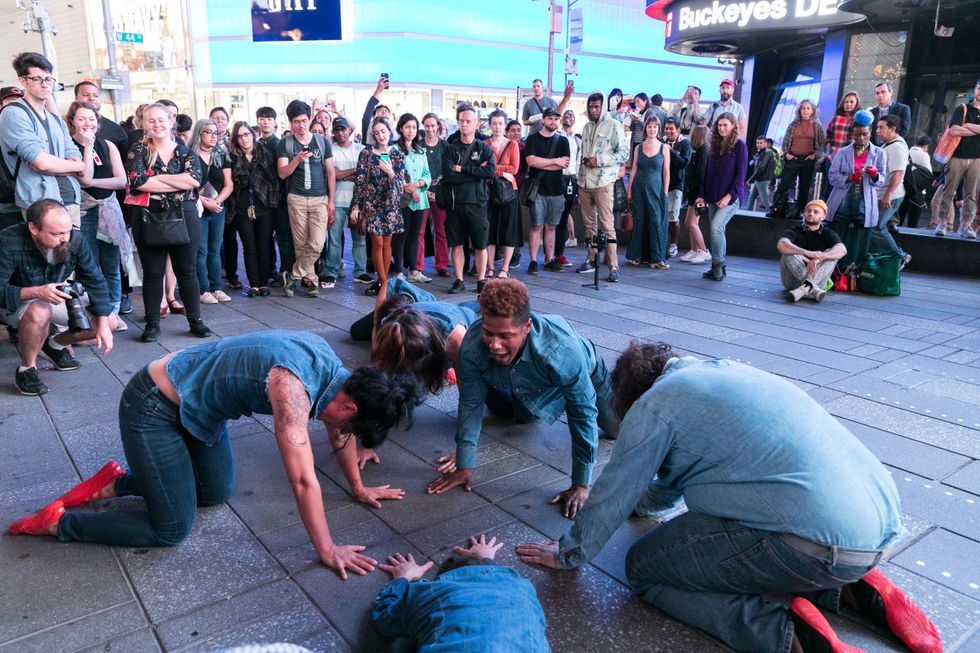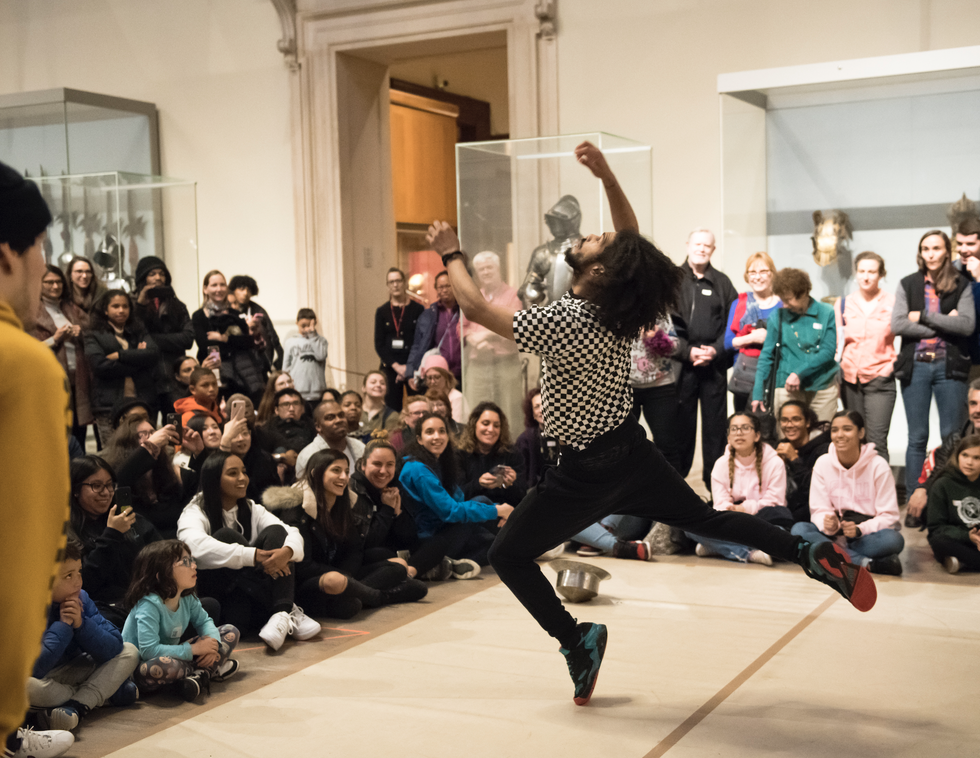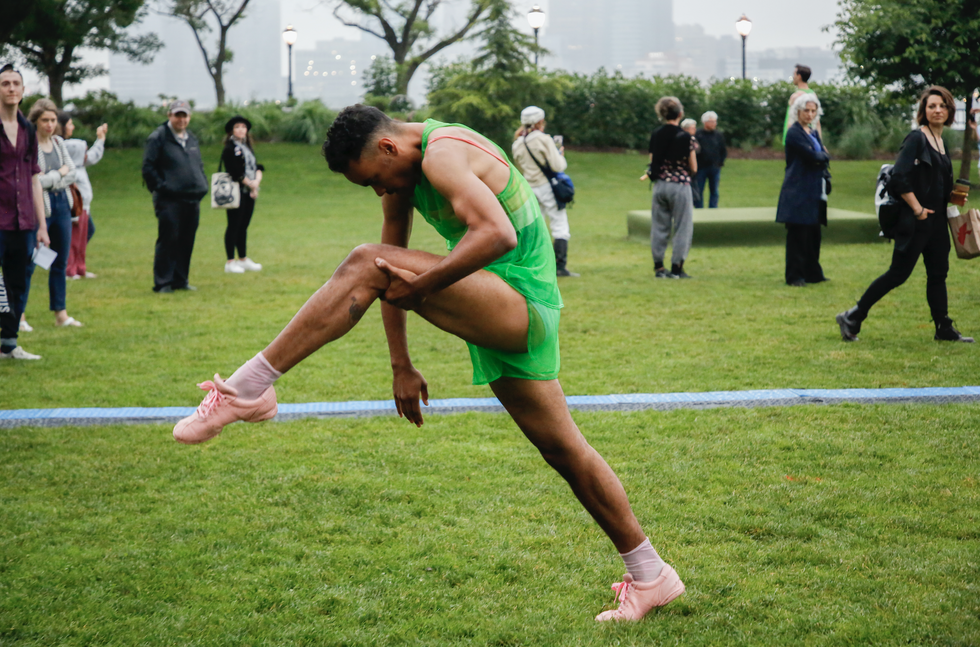Has Social Media Changed How We Experience Dance in Public Spaces?

New Mass Dance in Times Square in 2018 Rachel Papo
Especially in the last 10 years, it’s become increasingly common to see public dance works gracing our social media feeds. You can find dance in museum galleries, in parks or outside famous buildings. In 2018, Times Square Arts partnered with Danspace Project to present three site-specific works in the heart of one of the busiest intersections in the world. Before last year’s official opening of The Shed, a new performance venue in Manhattan, the space built excitement with a free outdoor preview festival, which included a reimagined William Forsythe pas de deux and a program by flex artist Reggie “Regg Roc” Gray, among others—taking advantage of passersby’s subsequent social posts to promote the opening.
Amidst all of this, how is the work itself faring? Social media is often credited with increasing exposure for dance, or helping to engage younger audience. But is it also changing how we watch site-specific dance, or affecting what gets programmed in the first place?
It’s not unusual for notions of how audiences should behave to evolve over time, says choreographer and speaker Sydney Skybetter, who often looks at the intersection between dance and technology. And with an influx of content on social platforms, like people filming themselves dancing for TikTok, the internet has broadened the dance community and made it possible to be a performer or an audience member in many different ways.
“This is maybe another opportunity to think really carefully about what a ‘dance community’ is constituted of,” Skybetter says. “Is it constituted of institutions, or is it a constellation of creators and audiences, curators and retweeters?”
In the case of site-specific dance, that community has to choose the experience they want to have. “Whether somebody’s yelling to put the phone down or somebody can’t wait to pick the phone up, this is about meaning-making,” Skybetter says. Some studies suggest that we’re more likely to forget about an experience we’ve photographed, but there can also be joy in reliving an experience by looking through photos later. “It’s making the decision for yourself as an audience member. Which kind of experience do you want to foreground: the one in the present or the one in the future?”
Limor Tomer, general manager of MetLiveArts, has programmed artists such as Silas Farley, Andrea Miller and Monica Bill Barnes at the Metropolitan Museum of Art. She admits that it can be annoying to watch people viewing a performance through their screens, but she also understands the impulse to take ownership over an experience.
“It’s a little bit like ‘I was there, this is my mark, this is my version of it. It’s a personal exchange between me and the dancers,’ ” she says. “It’s the same thing that makes people sign their name on a monument.”
Koplowitz, who has been creating site-specific dance since the 1980s, first started noticing a difference when audiences began bringing small digital cameras or basic camera phones to performances. With the release of the first iPhone in 2007, the number of people viewing performances through a lens exploded.
“Sometimes I feel people are distracted or not experiencing the work as fully as possible because they’re so busy recording it or taking photographs,” he says.
Still, he points out that the unpredictability of the audience has always been part of site-specific work. “As a site artist, you have to allow what happens with an audience to happen, and you have to accept it,” he says. “On some level you want people to be standing or sitting there in rapt attention. On the other hand, we’re in the middle of Fifth Avenue and 42nd Street.”

Paula Lobo, Courtesy Met Museum
Presenting dance in a public space automatically has a different set of guidelines than a traditional theater would, argues Lili Chopra, curator of the Lower Manhattan Cultural Council’s River to River Festival, a free summer arts festival in New York City. “You know that you need to create a different type of environment, and that the work needs to let go of the necessity of a real formality that you find in the context of a theater.” she says. “So in a sense, I don’t feel that seeing people engaging with the work in different ways is a distraction. I think it’s about being able to open up the doors to so many more potential audience members, and welcoming different behaviors.”
Whether those new potential audience members will go on to buy tickets to future dance performances, Chopra isn’t sure. To her, it’s more important that social media can help dance become part of a larger conversation. “The cumulative effect of having 15,000 people post photos—that’s important,” adds Tomer. “That’s going to change the field in a good way, and it changes the way people think about dance.”
The work also takes on a life of its own online. We’re often used to thinking of dance as an ephemeral, of-the-moment art form, but in the online world, in a way, a dance performance never really ends. “Performance happens in the moment, but then it has this long tail of consumption and resharing, possible virality,” Skybetter says. “The performance happens again and again, and it doesn’t necessarily ever go away.”
This can be a good thing, in terms of spreading the work to more people, but it can also add new challenges. “There’s a lot of competition for eyeballs,” Koplowitz says. “There’s been a real democratization in terms of how people have access to it, and in a sense, the bar is higher for people to get noticed.”
Though she’s well aware of the tendency among museums to program dance with the hope of bringing in more young people, Tomer doesn’t choose work based on how it will look on Instagram. “The point of doing a performance in a gallery is not to use the gallery as a beautiful, expensive backdrop,” she says. “It’s to somehow move the scholarship forward on both the choreography and the work of art, so if that’s not happening, then it doesn’t need to happen in a gallery. It should happen at The Joyce, where you can control for lighting and have a nice stage and not break the dancers’ knees.”
Still, Tomer does find that the inevitability of a piece ending up on social media can force artists to take certain things into consideration when making it.
“I do think some choreographers are keenly aware of the fact that they’re being filmed all the time, and that affects their decisions—spatial decisions, everything from costuming to movement,” she says. During open rehearsals in public galleries at the Met, they also have to adjust to museumgoers wandering through and photographing or filming them at work—sometimes even coming up to ask questions.

time is forever dividing itself by innumerable futures Whitney Browne, Courtesy River to River
Koplowitz points out that site-specific dance has always been used to promote certain locations, or draw people to them. When the British Library was moved to a new, unpopular location in 1998, for instance, he was commissioned to create a piece that could help attract more positive attention to the new space. “In some ways,” he says, “nothing has changed.”
We still have a lot to learn about what all this means for the future of performance. “We have the benefit of 400 years of understanding how proscenium performance has worked—the internet has only been around for a couple decades,” says Skybetter.
He sees opportunities for artists to make these new platforms work for them, rather than the other way around. “There’s a way here for choreographers and dance artists to lead, to not just respond to the zeitgeist but shape how these technologies are developed,” he says, naming examples like Kate Ladenheim, who’s experimented with augmented reality; or Larry Keigwin, one of the earliest dancemakers to explore cell phone culture in his site-specific work, even incorporating phones into some pieces. “These artists aren’t just trying to take a proscenium dance and put it on the internet, but trying to radically redefine how dance functions,” Skybetter says.
Tomer agrees, citing The New York Times‘ #SpeakingInDance series, a made-for-Instagram collection of bite-sized videos that explore various corners of the dance world. “It’s designed for social media and it’s beautiful and it works,” she says. “It’s not about documentation. It’s about creating work for that platform, which I love.”
For now, it’s still possible to enjoy both the had-to-be-there uniqueness of a live experience and its social media afterlife. Chopra points to last year’s premiere by Pam Tanowitz at River to River, in Rockefeller Park. Because the first performance got rained out, she says the dancers became even more eager to perform, creating a particularly special energy. Some people in the crowd—a mixture of die-hard dance fans and passersby—took out their phones, or wandered the park, while others stood in silent attention. The dancers, clad in green, traversed the park with their movement, sometimes finding themselves far from the audience, and other times creating an intimate atmosphere.
“It’s finding the right balance between complete chaos and yet being able to create these kinds of exquisite moments of sharing,” Chopra says.



